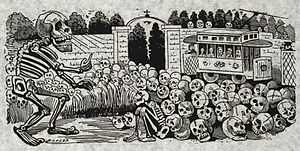Calavera


| Look up calavera in Wiktionary, the free dictionary. |
A calavera (pronounced: [kalaˈβeɾa], Spanish for "skull") is a representation of human skull made from either sugar or clay, which is used in the Mexican celebration of the Day of the Dead and the Roman Catholic holiday All Souls Day. Calavera can also refer to any artistic representations of skulls, such as the lithographs of José Guadalupe Posada.[1]
Sugar skulls
These candies are often made from sugar cane, usually in one piece without flavoring (except sometimes vanilla) and adorned with lines of vegetable dye, commonly in green, blue, yellow or red colors. Other variations of edible calaveras may be made of chocolate. The names of living people are commonly written on the foreheads and can be bought and given as gifts.[2] Calaveras may be eaten, or kept for a few days and then thrown away.
Clay skulls
Clay toy variations of calaveras also resemble the shape of human skulls. These toys are often painted a metallic silver color, but they may also be found in colors such as white, black, and red. Beaded eyes of contrasting colors may also be added.
Literary calaveras
Poetry written for the Day of the Dead are known as literary calaveras, and are intended to humorously criticize the living while reminding them of their mortality.[3][4] Literary calaveras appeared during the second half of the nineteenth century, when drawings critical of important politicians began to be published in the press. Living personalities were depicted as skeletons exhibiting recognizable traits, making them easily identifiable. Additionally, drawings of dead personalities often contained text elements providing details of the deaths of various individuals.
See also
- Calacas skeleton.
References
- ↑ About an José Guadalupe Posada's Calavera Revolucionaria, retrieved 2007-11-13,
Posada created many images of calaveras (skeletons) performing many different human activities. These images were/are used for the Day of The Dead celebrations in Mexico.
- ↑ Stanley Brandes (8 January 2007). Skulls to the Living, Bread to the Dead: The Day of the Dead in Mexico and Beyond. Wiley-Blackwell. p. 43. ISBN 978-1-4051-5248-8.
- ↑ Rangel, Sonia. "Calavera poetry reading slated for Nov. 1". Tejano Tribune. Retrieved 2007-11-13.
- ↑ Barradas, Francisco (2007-11-01). "Calaveras and Posadas". El Tecolote (in Spanish). Retrieved 2007-11-13.